The Compressive Behavior and Crashworthiness of Cork: A Review
Abstract
:1. Introduction
2. Natural Cork
2.1. Anisotropy
2.2. Other Parameters Affecting Cork Microstructure: Density, Porosity, Growth Rate and Origin
2.3. Effect of Testing Parameters and Conditions: Strain Rate, Stress Relaxation and Creep
2.4. Working Environment
2.5. Peculiar Features: Dimensional Recovery and Poisson’s Ratio
3. Agglomerated Cork
3.1. Compressive Behavior
3.2. Crashworthiness: Temperature, Multiple-Impacts and Applications
4. Conclusions
5. Future Perspectives
Author Contributions
Funding
Institutional Review Board Statement
Informed Consent Statement
Data Availability Statement
Conflicts of Interest
References
- Kaza, S.; Yao, L.C.; Bhada-Tata, P.; Van Woerden, F. What a Waste 2.0: A Global Snapshot of Solid Waste Management to 2050; World Bank Publications: Washington, DC, USA, 2018. [Google Scholar] [CrossRef]
- Silva, S.P.; Sabino, M.A.; Fernandes, E.M.; Correlo, V.M.; Boesel, L.F.; Reis, R.L. Cork: Properties, capabilities and applications. Int. Mater. Rev. 2005, 50. [Google Scholar] [CrossRef] [Green Version]
- Knapic, S.; Oliveira, V.; Machado, J.S.; Pereira, H. Cork as a building material: A review. Eur. J. Wood Wood Prod. 2016, 74, 775–791. [Google Scholar] [CrossRef]
- Leite, C.; Pereira, H. Cork-Containing Barks—A Review. Front. Mater. 2017, 3. [Google Scholar] [CrossRef] [Green Version]
- Aroso, I.M.; Araújo, A.R.R.; Pires, R.A.; Reis, R.L. Cork: Current Technological Developments and Future Perspectives for this Natural, Renewable, and Sustainable Material. ACS Sustain. Chem. Eng. 2017, 5, 11130–11146. [Google Scholar] [CrossRef]
- Pereira, H. Cork; Elsevier Science B.V.: Amsterdam, The Netherlands, 2007. [Google Scholar] [CrossRef]
- Gil, L. Cork Composites: A Review. Materials 2009, 2, 776–789. [Google Scholar] [CrossRef] [Green Version]
- Pereira, H. The Rationale behind Cork Properties: A Review of Structure and Chemistry. BioResources 2015, 10, 6207–6229. [Google Scholar] [CrossRef]
- Gibson, L.J.; Easterling, K.E.; Ashby, M.F. The Structure and Mechanics of Cork. Proc. R. Soc. A Math. Phys. Eng. Sci. 1981, 377, 99–117. [Google Scholar] [CrossRef]
- Fortes, M.; Rosa, M. Densidade da cortiça: Factores que a influenciam. Cortiça 1988, 593, 65–68. [Google Scholar]
- Ramos, M.; Rocheta, M.; Carvalho, L.; Inácio, V.; Graça, J.; Morais-Cecilio, L. Expression of DNA methyltransferases is involved in Quercus suber cork quality. Tree Genet. Genomes 2013, 9, 1481–1492. [Google Scholar] [CrossRef] [Green Version]
- Marat-Mendes, J.N.; Neagu, E.R. The Study of Electrical Conductivity of Cork. Ferroelectrics 2003, 294, 123–131. [Google Scholar] [CrossRef]
- Medeiros, H. Insulation Corkboard—Steambaked Insulation Corkboard. Methods and Plans for Application in Civil Constructions [Cork Oaks]. Junta Nacional de Cortiça: Lisboa, Portugal, 1945. [Google Scholar]
- Gil, L. Portugal. Cortiça: Produção, Tecnologia e Aplicação; GRAFICA ROSIAL LDA: Lisbon, Portugal, 1998. [Google Scholar]
- Matias, L.; Santos, C.; Reis, M.; Gil, L. Declared value for the thermal conductivity coefficient of insulation corkboard. Wood Sci. Technol. 1997, 31, 355–365. [Google Scholar] [CrossRef]
- Fonseca, A.L.; Brazinha, C.; Pereira, H.; Crespo, J.G.; Teodoro, O.M.N.D. Permeability of Cork for Water and Ethanol. J. Agric. Food Chem. 2013, 61, 9672–9679. [Google Scholar] [CrossRef] [PubMed]
- Fatima-Vaz, M.; Fortes, M.A. Friction properties of cork. J. Mater. Sci. 1998, 3, 3–9. [Google Scholar]
- Kottner, R.; Kocáb, J.; Heczko, J.; Krystek, J. Investigation of the mechanical properties of a cork/rubber composite. Mater. Tehnol. 2016, 50, 579–583. [Google Scholar] [CrossRef]
- Kocáb, J.; Kottner, R.; Kossa, A. Characterization of a cork-rubber composite using advanced material models. Mater. Today Proc. 2019, 12, 340–345. [Google Scholar] [CrossRef]
- Duarte, A.P.; Bordado, J.C. Cork—A Renewable Raw Material: Forecast of Industrial Potential and Development Priorities. Front. Mater. 2015, 2, 1–8. [Google Scholar] [CrossRef] [Green Version]
- Saadallah, Y. Modeling of mechanical behavior of cork in compression. Frat. Ed. Integrità Strutt. 2020, 53, 417–425. [Google Scholar] [CrossRef]
- Pereira, H. Variability of the Chemical Composition of Cork. BioResources 2013, 8, 2246–2256. [Google Scholar] [CrossRef]
- Pereira, H. Chemical composition and variability of cork from Quercus suber L. Wood Sci. Technol. 1988, 22, 211–218. [Google Scholar] [CrossRef]
- Pereira, H.; Graça, J.; Baptista, C. The Effect of Growth Rate on the Structure and Compressive Properties of Cork. IAWA Bull. 1992, 13, 389–396. [Google Scholar] [CrossRef]
- Anjos, O.; Pereira, H.; Rosa, M.E. Effect of quality, porosity and density on the compression properties of cork. Holz Als Roh-Und Werkstoff 2008, 66, 295–301. [Google Scholar] [CrossRef]
- Anjos, O.; Rodrigues, C.; Morais, J.; Pereira, H. Effect of density on the compression behaviour of cork. Mater. Des. 2014, 53, 1089–1096. [Google Scholar] [CrossRef]
- Oliveira, V.; Rosa, M.E.; Pereira, H. Variability of the compression properties of cork. Wood Sci. Technol. 2014, 48, 937–948. [Google Scholar] [CrossRef]
- Shahzad, A. Hemp fiber and its composites—A review. J. Compos. Mater. 2012, 46, 973–986. [Google Scholar] [CrossRef]
- Rosa, M.E.; Fortes, M.A. Rate effects on the compression and recovery of dimensions of cork. J. Mater. Sci. 1988, 23, 879–885. [Google Scholar] [CrossRef]
- Rosa, M.E.; Fortes, M.A. Stress relaxation and creep of cork. J. Mater. Sci. 1988, 23, 35–42. [Google Scholar] [CrossRef]
- Pereira, H. The thermochemical degradation of cork. Wood Sci. Technol. 1992, 26, 259–269. [Google Scholar] [CrossRef]
- Rosa, M.E.; Fortes, M.A. Temperature-induced alterations of the structure and mechanical properties of cork. Mater. Sci. Eng. 1988, 100, 69–78. [Google Scholar] [CrossRef]
- Rosa, B.M.E.; Pereira, H. The Effect of Long Term Treatment at 100 °C–150 °C on Structure, Chemical Composition and Compression Behaviour of Cork. Holzforschung 1994, 48, 226–232. [Google Scholar] [CrossRef]
- Lagorce-Tachon, A.; Karbowiak, T.; Champion, D.; Gougeon, R.D.; Bellat, J.-P. Mechanical Properties of Cork: Effect of Hydration. Mater. Des. 2015, 82, 489–496. [Google Scholar] [CrossRef]
- Rosa, M.E.; Fortes, M.A. Effects of water vapour heating on structure and properties of cork. Wood Sci. Technol. 1989, 34, 27–34. [Google Scholar] [CrossRef]
- Chen, X.; Moughames, J.; Ji, Q.; Martínez, J.A.I.; Tan, H.; Adrar, S.; Laforge, N.; Cote, J.-M.; Euphrasie, S.; Ulliac, G.; et al. Optimal isotropic, reusable truss lattice material with near-zero Poisson’s ratio. Extreme Mech. Lett. 2020, 41, 101048. [Google Scholar] [CrossRef]
- Fortes, M.A.; Nogueira, M.T. The Poisson Effect in Cork. Mater. Sci. Eng. 1989, 122, 227–232. [Google Scholar] [CrossRef]
- Díaz-Maroto, M.; Viñas, M.L.; Marchante, L.; Alañón, M.; Díaz-Maroto, I.; Pérez-Coello, M. Evaluation of the Storage Conditions and Type of Cork Stopper on the Quality of Bottled White Wines. Molecules 2021, 26, 232. [Google Scholar] [CrossRef]
- Rossetti, F.; Jouin, A.; Jourdes, M.; Teissedre, P.-L.; Foligni, R.; Longo, E.; Boselli, E. Impact of Different Stoppers on the Composition of Red and Rosé Lagrein, Schiava (Vernatsch) and Merlot Wines Stored in Bottle. Molecules 2020, 25, 4276. [Google Scholar] [CrossRef]
- Prata, J.C.; Paço, A.; Reis, V.; da Costa, J.P.; Fernandes, A.J.S.; da Costa, F.M.; Duarte, A.C.; Rocha-Santos, T. Identification of microplastics in white wines capped with polyethylene stoppers using micro-Raman spectroscopy. Food Chem. 2020, 331, 127323. [Google Scholar] [CrossRef]
- Santos, P.T.; Pinto, S.; Marques, P.A.A.P.; Pereira, A.B.; De Sousa, R.J.A. Agglomerated cork: A way to tailor its mechanical properties. Compos. Struct. 2017, 178, 277–287. [Google Scholar] [CrossRef]
- Crouvisier-Urion, K.; Bellat, J.-P.; Gougeon, R.D.; Karbowiak, T. Mechanical properties of agglomerated cork stoppers for sparkling wines: Influence of adhesive and cork particle size. Compos. Struct. 2018, 203, 789–796. [Google Scholar] [CrossRef]
- Jardin, R.T.; Fernandes, F.A.O.; Pereira, A.B.; de Sousa, R.A.J. Static and dynamic mechanical response of different cork agglomerates. Mater. Des. 2015, 68, 121–126. [Google Scholar] [CrossRef]
- Le Barbenchon, L.; Girardot, J.; Kopp, J.; Viot, P. Strain Rate Effect on the Compressive Behaviour of Reinforced Cork Agglomerates. In Proceedings of the 12th International Conference on the Mechanical and Physical Behaviour of Materials under Dynamic Loading, Arcachon, France, 9–14 September 2018; Volume 183, p. 03018. [Google Scholar]
- Le Barbenchon, L.; Kopp, J.-B.; Girardot, J.; Viot, P. Reinforcement of cellular materials with short fibres: Application to a bio-based cork multi-scale foam. Mech. Mater. 2020, 142, 103271. [Google Scholar] [CrossRef]
- Ptak, M.; Kaczyński, P.; Wilhelm, J.; Margarido, J.M.T.; Marques, P.A.A.P.; Pinto, S.C.; de Sousa, R.J.A.; Fernandes, F.A.O. Graphene-Enriched Agglomerated Cork Material and Its Behaviour under Quasi-Static and Dynamic Loading. Materials 2019, 12, 151. [Google Scholar] [CrossRef] [PubMed] [Green Version]
- Le Barbenchon, L.; Girardot, J.; Kopp, J.; Viot, P. Multi-scale foam: 3D structure/compressive behaviour relationship of agglomerated cork. Materialia 2019, 5, 100219. [Google Scholar] [CrossRef] [Green Version]
- Sergi, C.; Sarasini, F.; Tirillò, J.; Barbero, E.; Sanchez-Saez, S.; Sasso, M.; Mancini, E. Temperature, strain rate and anisotropy effects on compressive response of natural and synthetic cellular core materials. Compos. Struct. 2021, 260, 113268. [Google Scholar] [CrossRef]
- Sergi, C.; Tirillò, J.; Sarasini, F.; Barbero Pozuelo, E.; Sanchez-Saez, S.; Burgstaller, C. The Potential of Agglomerated Cork for Sandwich Structures: A Systematic Investigation of Physical, Thermal, and Mechanical Properties. Polymers 2019, 11, 2118. [Google Scholar] [CrossRef] [Green Version]
- Sergi, C.; Tirillò, J.; Sarasini, F.; Russo, P.; Barbero, E.; Sanchez-Saez, S. Cork core sandwich structures: Static and dynamic response. ICCM22 Int. Conf. Compos. Mater. 2019, 849–859. [Google Scholar] [CrossRef]
- Gameiro, C.P.; Cirne, J.; Gary, G. Experimental study of the quasi-static and dynamic behaviour of cork under compressive loading. J. Mater. Sci. 2007, 42, 4316–4324. [Google Scholar] [CrossRef]
- Gómez, A.; Sanchez-Saez, S.; Barbero, E. Compression impact behaviour of agglomerated cork at intermediate strain rates. Eur. J. Wood Wood Prod. 2021, 79, 381–396. [Google Scholar] [CrossRef]
- Sasso, M.; Mancini, E.; Chiappini, G.; Sarasini, F.; Tirilló, J. Application of DIC to Static and Dynamic Testing of Agglomerated Cork Material. Exp. Mech. 2018, 58, 1017–1033. [Google Scholar] [CrossRef]
- Buil, R.M.; Angulo, D.R.; Ivens, J. Analysis of the capability of cork and cork agglomerates to absorb multiple compressive quasi-static loading cycles. Eur. J. Wood Wood Prod. 2021, 79, 1195–1208. [Google Scholar] [CrossRef]
- Sanchez-Saez, S.; García-Castillo, S.K.; Barbero, E.; Cirne, J. Dynamic crushing behaviour of agglomerated cork. Mater. Des. 2015, 65, 743–748. [Google Scholar] [CrossRef] [Green Version]
- Kaczyński, P.; Ptak, M.; Fernandes, F.A.O.; Chybowski, L.; Wilhelm, J.; De Sousa, R.J.A. Development and Testing of Advanced Cork Composite Sandwiches for Energy-Absorbing Structures. Materials 2019, 12, 697. [Google Scholar] [CrossRef] [Green Version]
- Kaczynski, P.; Ptak, M.; Wilhelm, J.; Fernandes, F.A.O.; De Sousa, R.J.A. High-energy impact testing of agglomerated cork at extremely low and high temperatures. Int. J. Impact Eng. 2019, 126, 109–116. [Google Scholar] [CrossRef]
- Ptak, M.; Kaczynski, P.; Fernandes, F.A.O.; de Sousa, R.J.A. Assessing impact velocity and temperature effects on crashworthiness properties of cork material. Int. J. Impact Eng. 2017, 106, 238–248. [Google Scholar] [CrossRef]
- Sanchez-Saez, S.; Barbero, E.; Garcia-Castillo, S.K.; Ivañez, I.; Cirne, J. Experimental response of agglomerated cork under multi-impact loads. Mater. Lett. 2015, 160, 327–330. [Google Scholar] [CrossRef] [Green Version]
- Sergi, C.; Sarasini, F.; Barbero, E.; Sanchez-Saez, S.; Tirillò, J. Assessment of agglomerated corks and PVC foams cores crashworthiness under multiple-impact events in different loading conditions. Polym. Test. 2021, 96, 107061. [Google Scholar] [CrossRef]
- Buil, R.M.; Angulo, D.R.; Ivens, J.; Blasco, J.O.A. Experimental study of natural cork and cork agglomerates as a substitute for expanded polystyrene foams under compressive loads. Wood Sci. Technol. 2021, 55, 419–443. [Google Scholar] [CrossRef]
- Fernandes, F.A.O.; Jardin, R.T.; Pereira, A.B.; de Sousa, R.J.A. Comparing the mechanical performance of synthetic and natural cellular materials. Mater. Des. 2015, 82, 335–341. [Google Scholar] [CrossRef]
- Fernandes, F.A.O.; Pascoal, R.J.S.; De Sousa, R.J.A. Modelling impact response of agglomerated cork. J. Mater. 2014, 58, 499–507. [Google Scholar] [CrossRef]
- Paiva, D.; Magalhães, F.D. Dynamic mechanical analysis and creep-recovery behavior of agglomerated cork. Eur. J. Wood Wood Prod. 2017, 76, 133–141. [Google Scholar] [CrossRef]
- Cordeiro, N.; Belgacem, M.N.; Silvestre, A.J.D.; Neto, C.P.; Gandini, A. Cork suberin as a new source of chemicals. 1. Isolation and chemical characterization of its composition. Int. J. Biol. Macromol. 1998, 22, 71–80. [Google Scholar] [CrossRef]
- Varela, M.M.; Fernandes, F.A.O.; De Sousa, R.J.A. Development of an Eco-Friendly Head Impact Protection Device. Appl. Sci. 2020, 10, 2492. [Google Scholar] [CrossRef] [Green Version]
- Fernandes, F.A.O.; De Sousa, R.J.A.; Ptak, M.; Migueis, G. Helmet Design Based on the Optimization of Biocomposite Energy-Absorbing Liners under Multi-Impact Loading. Appl. Sci. 2019, 9, 735. [Google Scholar] [CrossRef] [Green Version]
- Coelho, R.M.; De Sousa, R.J.A.; Fernandes, F.A.O.; Texeira-Dias, F. New composite liners for energy absorption purposes. Mater. Des. 2013, 43, 384–392. [Google Scholar] [CrossRef]
- Costas, M.; Díaz, J.; Romera, L.E.; Hernández, S.; Tielas, A. Static and dynamic axial crushing analysis of car frontal impact hybrid absorbers. Int. J. Impact Eng. 2013, 62, 166–181. [Google Scholar] [CrossRef]
- Paulino, M.; Teixeira-Dias, F. An energy absorption performance index for cellular materials—Development of a side-impact cork padding. Int. J. Crashworthiness 2011, 16, 135–153. [Google Scholar] [CrossRef]
- Tay, Y.Y.; Lim, C.S.; Lankarani, H.M. A finite element analysis of high-energy absorption cellular materials in enhancing passive safety of road vehicles in side-impact accidents. Int. J. Crashworthiness 2014, 19, 288–300. [Google Scholar] [CrossRef]
- Castro, O.; Silva, J.M.; Devezas, T.; Silva, A.; Gil, L. Cork agglomerates as an ideal core material in lightweight structures. Mater. Des. 2010, 31, 425–432. [Google Scholar] [CrossRef] [Green Version]
- Silva, J.M.; Nunes, C.Z.; Franco, N.; Gamboa, P.V. Damage tolerant cork based composites for aerospace applications. Aeronaut. J. 2011, 115, 567–575. [Google Scholar] [CrossRef]
- Zhang, Y.; Yuan, Z.; Xu, C.C. 8. Bio-based resins for fiber-reinforced polymer composites. In Natural Fiber-Reinforced Biodegradable and Bioresorbable Polymer Composites; Elsevier Ltd.: Amsterdam, The Netherlands, 2017; pp. 137–162. [Google Scholar] [CrossRef]
- Sergi, C.; Sarasini, F.; Fiore, V.; Barbero, E.; Sanchez-Saez, S.; Tirillò, J. The effects of water absorption and salt fog exposure on agglomerated cork compressive response. Eur. J. Wood Wood Prod. 2021. [Google Scholar] [CrossRef]

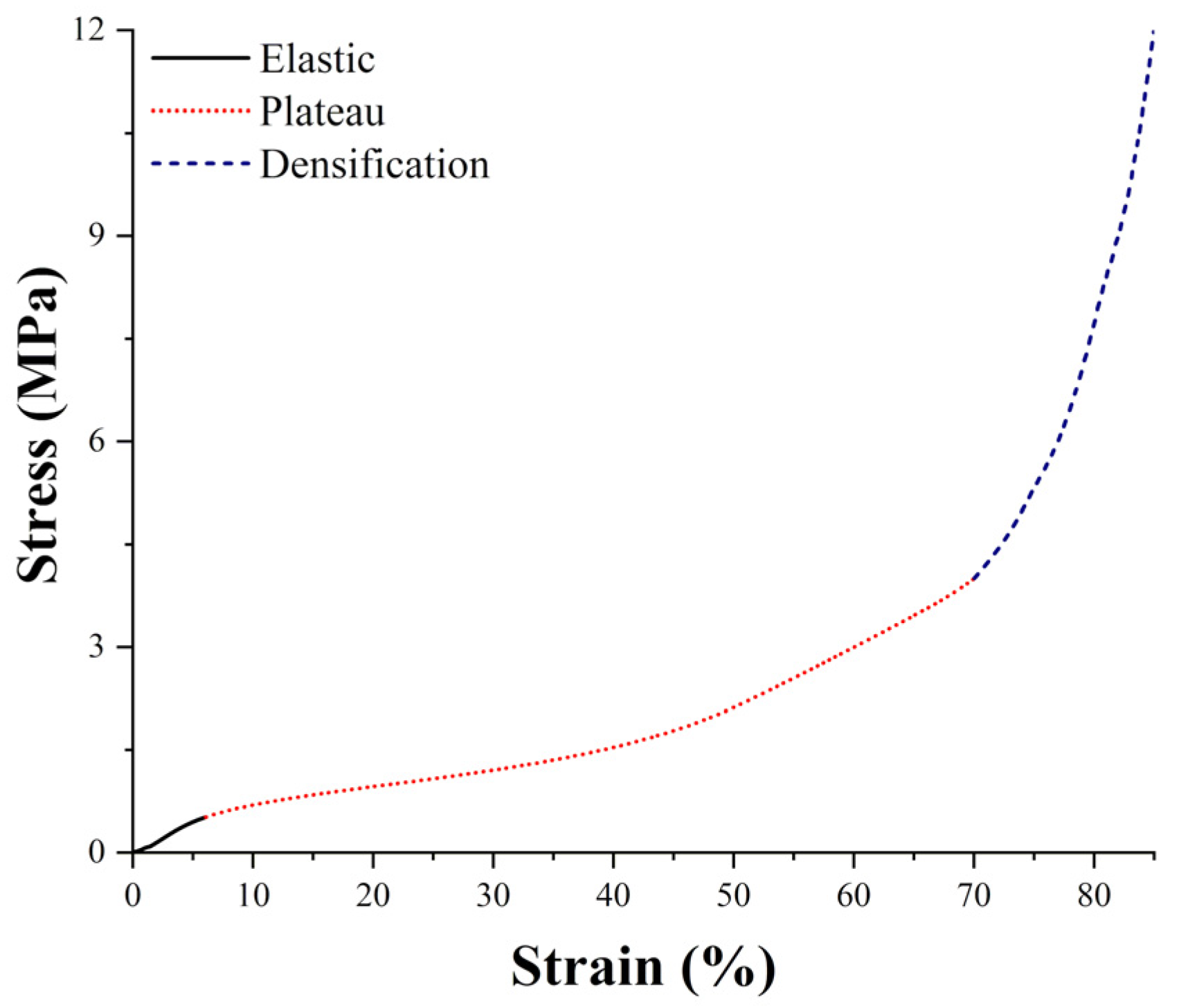
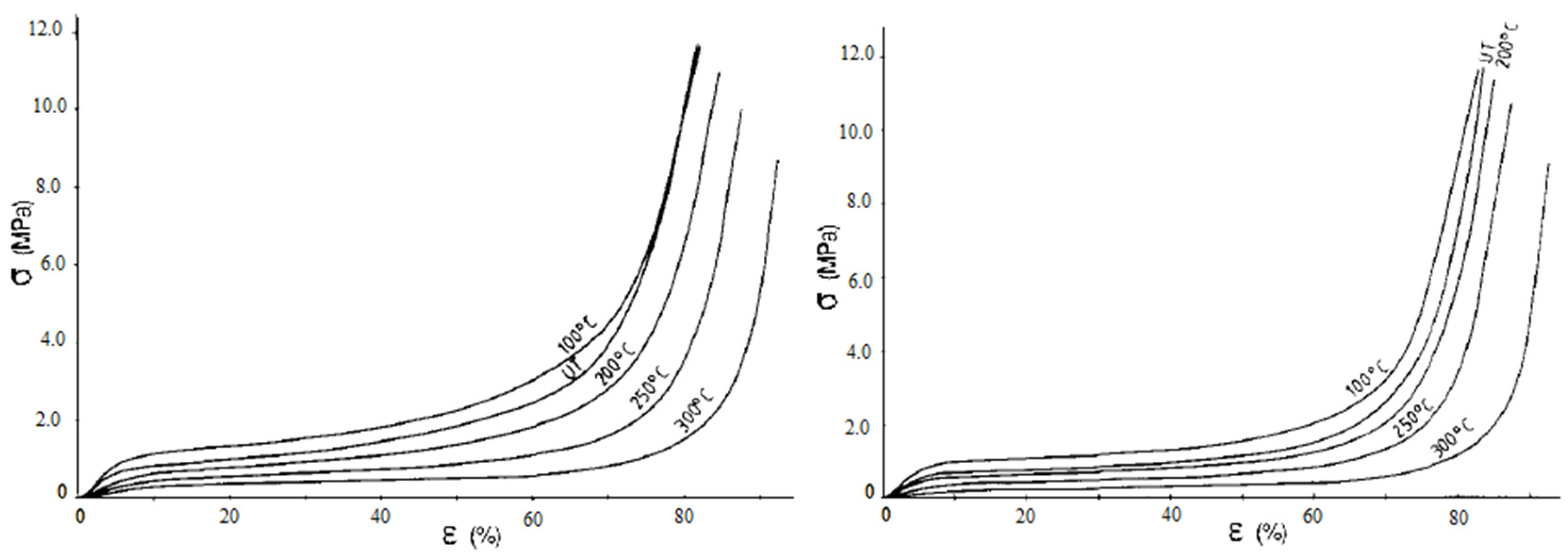
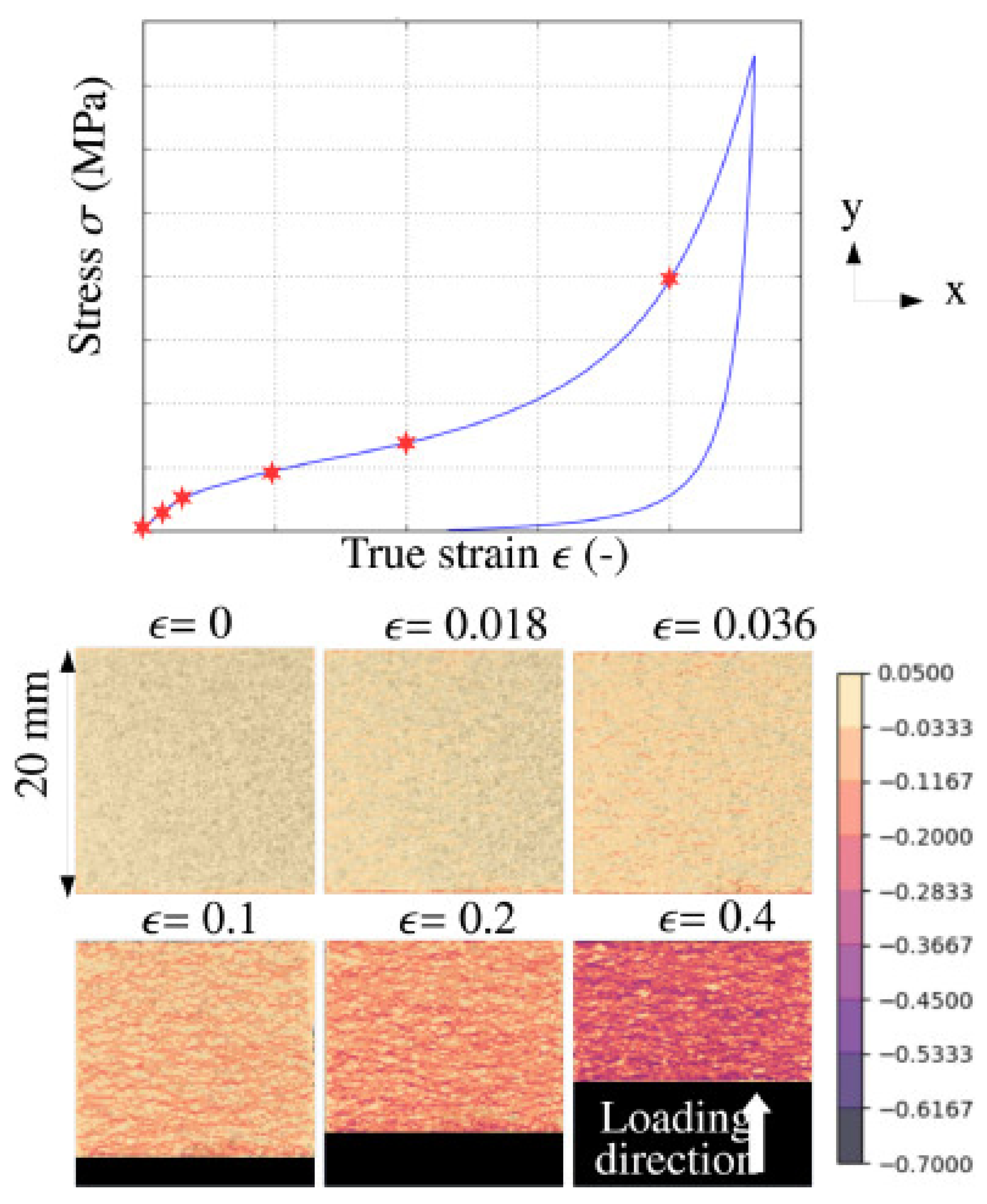
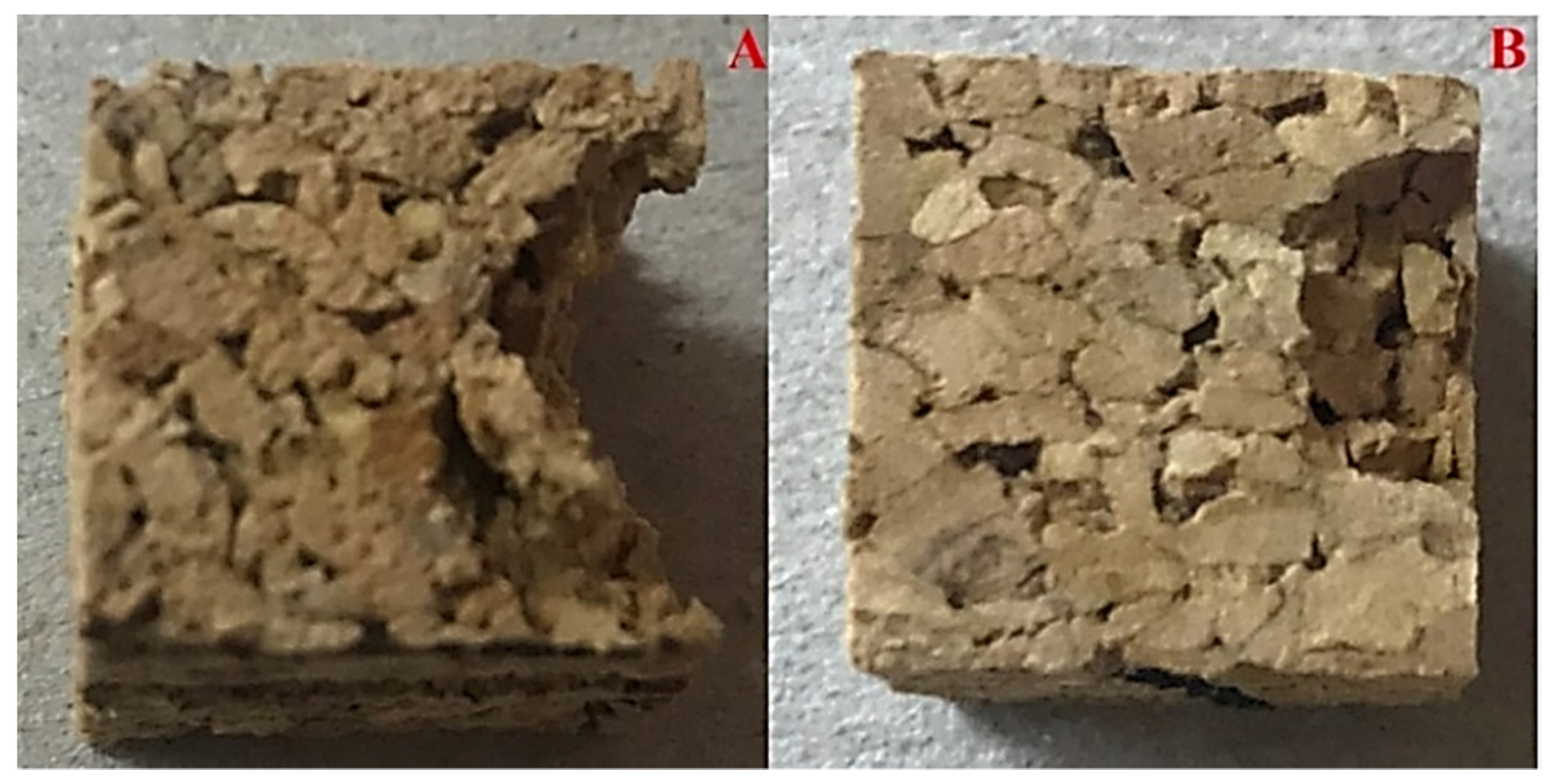
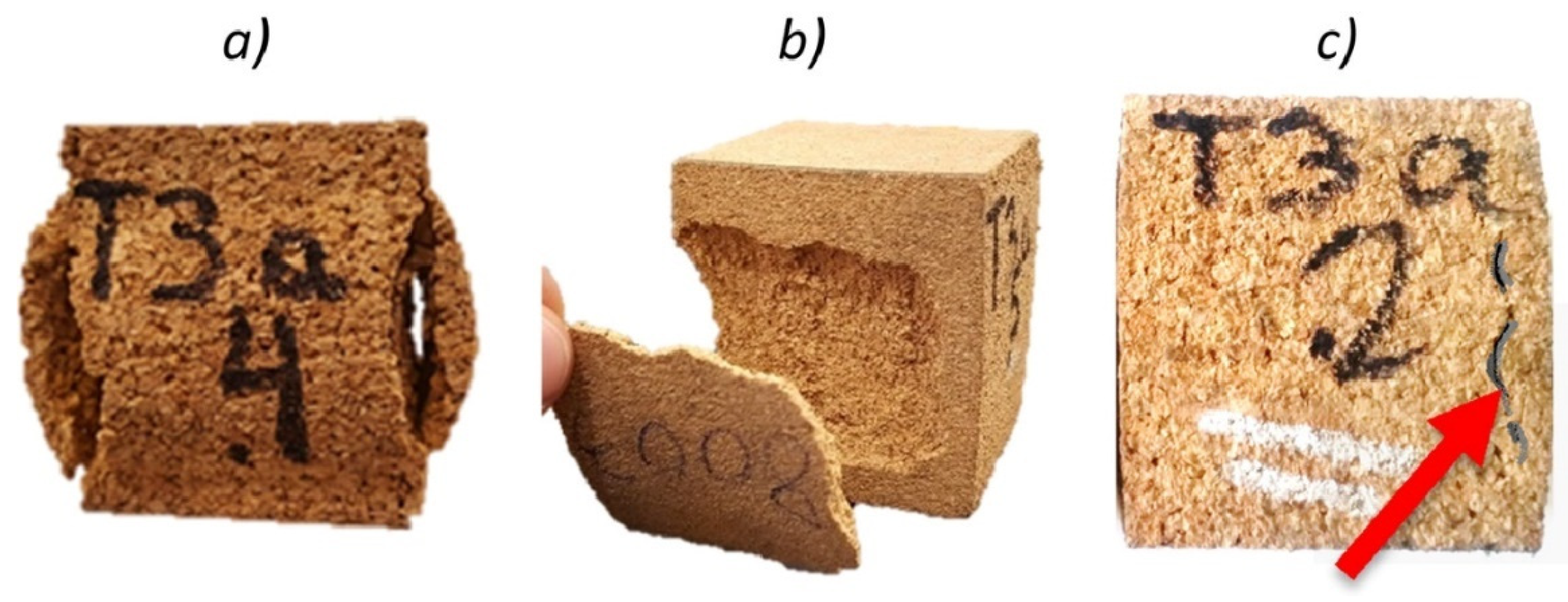


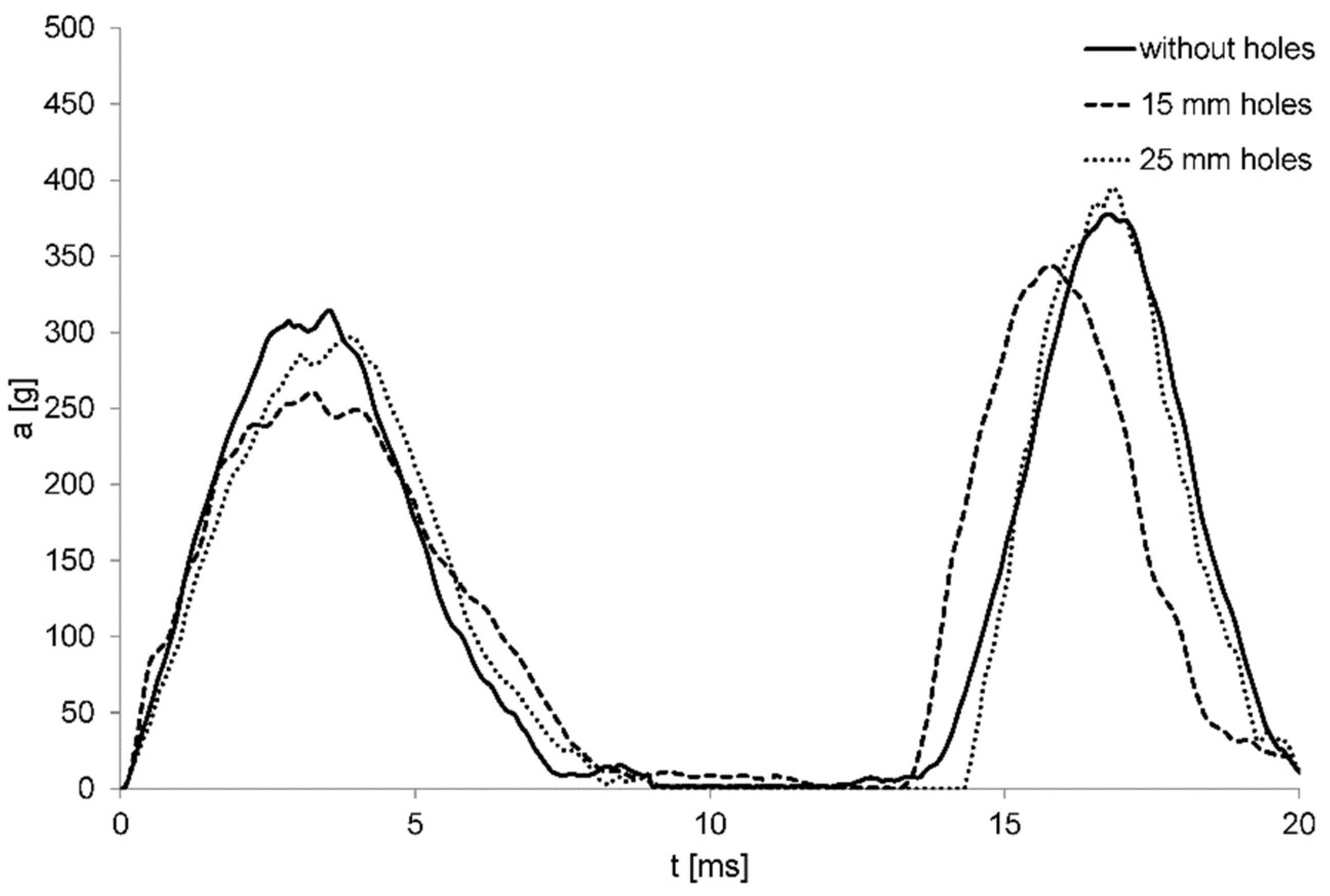
| Property | Value | Ref. |
|---|---|---|
| Density [kg/m3] | 120–240 | [10] |
| 200–400 | [11] | |
| Electrical Conductivity [S/m] | 1.26 × 10−10 (25 °C) 1.67 × 10−13 (50 °C) | [12] |
| Acoustic Resistivity [kg/(m2 s)] | 1.2 × 105 | [13] |
| Thermal Conductivity [(W/(m K))] | 0.045 | [14,15] |
| Specific Heat [J/(kg K)] | 350 | [14] |
| Permeability [mol/(m s Pa)] | 280.5 × 10−13 (Liquid water) 110.1 × 10−13 (Water Vapor) | [16] |
| Friction Coefficient | 0.97 (radial) 0.77 (non-radial) | [17] |
| Component | Pereira [22] | Gil [14] | Pereira [23] | |||
|---|---|---|---|---|---|---|
| Suberin | 42.8% | 42% | 37.8% | 40.3% | 35.2% | 41.2% |
| Lignin | 22% | 21.5% | 21.7% | 22% | 22.4% | 20.7% |
| Polysaccharide (Cellulose/Hemicellulose) | 19% | 16% | 18.5% | 15.7% | 21.3% | 17.2% |
| Extractives (Water, Ethanol, Dichloromethane) | 16.2% | 13% | 15.7% | 14.3% | 16.9% | 14.1% |
| Others | - | 7% | - | - | - | - |
| Compressive Modulus (MPa) | Plateau Stress (MPa) | |||||
|---|---|---|---|---|---|---|
| Radial | Axial | Tangential | Radial | Axial | Tangential | |
| Gibson [9] | 20 ± 7 | 13 ± 5 | 13 ± 5 | 0.8 ± 0.2 | 0.7 ± 0.2 | 0.7 ± 0.2 |
| Pereira [24] 1 | 11.5 ± 1.0 13.2 ± 0.7 9.9 ± 0.4 | 10.9 ± 0.6 12.0 ± 1.5 9.2 ± 0.5 | 8.6 ± 0.7 9.6 ± 1.4 7.9 ± 1.3 | - | - | - |
| Anjos [25] 2 | 17.9 ± 2.86 18.6 ± 3.31 | 16.6 ± 1.76 17.1 ± 2.27 | 13.4 ± 1.42 11.2 ± 1.73 | 0.61 ± 0.057 0.59 ± 0.068 | 0.59 ± 0.061 0.57 ± 0.104 | 0.56 ± 0.044 0.44 ± 0.048 |
| Anjos [26] 3 | 17.39 ± 4.53 22.57 ± 5.07 26.12 ± 4.5 | 16.61 ± 3.28 16.26 ± 2.57 18.53 ± 5.19 | 14.39 ± 4.79 16.75 ± 3.88 19.07 ± 4.47 | 0.72 ± 0.09 0.74 ± 0.15 0.74 ± 0.11 | 0.57 ± 0.08 0.32 ± 0.14 0.52 ± 0.11 | 0.65 ± 0.10 0.56 ± 0.21 0.75 ± 0.09 |
| Oliveira [27] 4 | 10.4 ± 3 | 9.2 ± 2.6 | 9.2 ± 2.6 | - | - | - |
| Poisson’s Ratio | |||
|---|---|---|---|
| R/NR | NR/R | NR/NR | |
| Gibson et al. [9] | 0 ± 0.05 | 0 ± 0.05 | 0.5 ± 0.05 |
| Fortes et al. [37] | 0.097 | 0.064 | 0.26 |
| Compressive Modulus (MPa) | |||
|---|---|---|---|
| Santos [41] | Crouvisier-Urion [42] | Jardin [43] | |
| Binder type (Rigidity) | ↑ | ↑ | none |
| Binder concentration | =↓ | = | none |
| Grain Size | ↑ | ↑ | ↑ |
| Density | ↑ | none | ↑ |
Publisher’s Note: MDPI stays neutral with regard to jurisdictional claims in published maps and institutional affiliations. |
© 2021 by the authors. Licensee MDPI, Basel, Switzerland. This article is an open access article distributed under the terms and conditions of the Creative Commons Attribution (CC BY) license (https://creativecommons.org/licenses/by/4.0/).
Share and Cite
Sergi, C.; Sarasini, F.; Tirillò, J. The Compressive Behavior and Crashworthiness of Cork: A Review. Polymers 2022, 14, 134. https://doi.org/10.3390/polym14010134
Sergi C, Sarasini F, Tirillò J. The Compressive Behavior and Crashworthiness of Cork: A Review. Polymers. 2022; 14(1):134. https://doi.org/10.3390/polym14010134
Chicago/Turabian StyleSergi, Claudia, Fabrizio Sarasini, and Jacopo Tirillò. 2022. "The Compressive Behavior and Crashworthiness of Cork: A Review" Polymers 14, no. 1: 134. https://doi.org/10.3390/polym14010134
APA StyleSergi, C., Sarasini, F., & Tirillò, J. (2022). The Compressive Behavior and Crashworthiness of Cork: A Review. Polymers, 14(1), 134. https://doi.org/10.3390/polym14010134








